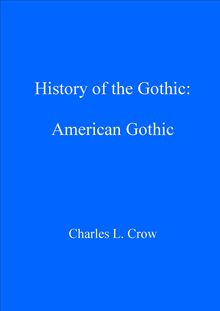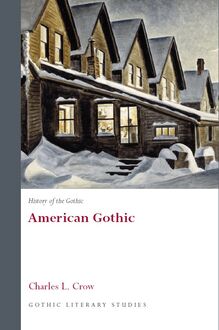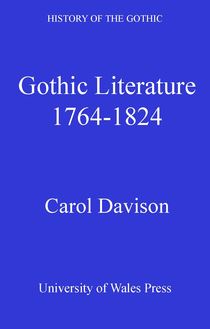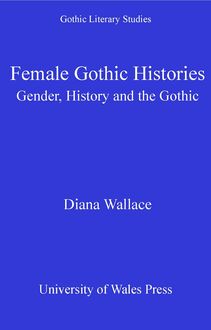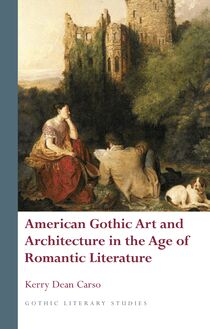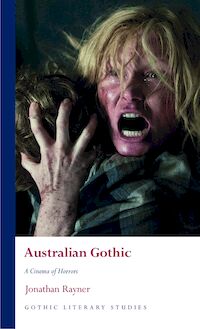History of the Gothic: Gothic Literature 1825-1914 , livre ebook
127
pages
English
Ebooks
2009
Vous pourrez modifier la taille du texte de cet ouvrage
Obtenez un accès à la bibliothèque pour le consulter en ligne En savoir plus
Découvre YouScribe en t'inscrivant gratuitement
Découvre YouScribe en t'inscrivant gratuitement
127
pages
English
Ebooks
2009
Vous pourrez modifier la taille du texte de cet ouvrage
Obtenez un accès à la bibliothèque pour le consulter en ligne En savoir plus
Publié par
Date de parution
01 juin 2009
Nombre de lectures
0
EAN13
9781783163892
Langue
English
History of the Gothic: Gothic Literature 1825-1914 is a detailed and accessible study of Gothic literature in the nineteenth century. It examines how the themes and tropes associated with the early Gothic novel were diffused widely in many different genres in the Victorian period, including the ghost story, the regional novel, children's literature and the realist novel. It looks in particular at how the Gothic attempted to resolve the psychological and theological problems thrown up by the modernization and secularization of British society. The book argues that the fetishized figure of the child came to stand for what many believed was being lost by the headlong rush into a technological and industrial future. The relationship between regionalism and horror is examined, the use of the occult in the Gothic is detailed and the book demonstrates that, far from being a simple rejection or acceptance of secularization, the Gothic attempts to articulate an entirely different way of being modern.
Publié par
Date de parution
01 juin 2009
Nombre de lectures
0
EAN13
9781783163892
Langue
English
GOTHIC LITERATURE 1825-1914
S ERIES P REFACE
Gothic Literary Studies is dedicated to publishing groundbreaking scholarship on Gothic in literature and film. The Gothic, which has been subjected to a variety of critical and theoretical approaches, is a form which plays an important role in our understanding of literary, intellectual and cultural histories. The series seeks to promote challenging and innovative approaches to Gothic which question any aspect of the Gothic tradition or perceived critical orthodoxy.
Volumes in the series explore how issues such as gender, religion, nation and sexuality have shaped our view of the Gothic tradition. Both academically rigorous and informed by the latest developments in critical theory, the series provides an important focus for scholastic developments in Gothic studies, literary studies, cultural studies and critical theory. The series will be of interest to students of all levels and to scholars and teachers of the Gothic and literary and cultural histories.
S ERIES E DITORS
Andrew Smith, University of Glamorgan
Benjamin F. Fisher, University of Mississippi
E DITORIAL B OARD
Kent Ljungquist, Worcester Polytechnic Institute Massachusetts
Richard Fusco, St Joseph s University, Philadelphia
David Punter, University of Bristol
Chris Baldick, University of London
Angela Wright, University of Sheffield
Jerrold E. Hogle, University of Arizona
HISTORY OF THE GOTHIC
Gothic Literature 1825-1914
Jarlath Killeen
Jarlath Killeen, 2009
All rights reserved. No part of this book may be reproduced in any material form (including photocopying or storing it in any medium by electronic means and whether or not transiently or incidentally to some other use of this publication) without the written permission of the copyright owner except in accordance with the provisions of the Copyright, Designs and Patents Act 1988 or under the terms of a licence issued by the Copyright Licensing Agency Ltd, Saffron House, 6-10 Kirby Street, London, EC1N 8TS. Applications for the copyright owner s written permission to reproduce any part of this publication should be addressed to the University of Wales Press, 10 Columbus Walk, Brigantine Place, Cardiff, CF10 4UP.
www.uwp.co.uk
British Library Cataloguing-in-Publication Data
A catalogue record for this book is available from the British Library.
ISBN 978-0-7083-2070-9 (hardback) 978-0-7083-2069-3 (paperback)
e-ISBN 978-1-78316-389-2
The right of Jarlath Killeen to be identified as author of this work has been asserted in accordance with sections 77 and 79 of the Copyright, Designs and Patents Act 1988.
Oliver s reception by Fagin from The Adventures of Oliver Twist. Classic Image / Alamy.
C ONTENTS
Series Editors Foreword
Acknowledgements
Introduction
1 The Ghosts of Time
2 The Horror of Childhood
3 Regional Gothic
4 Ghosting the Gothic and the New Occult
Conclusion: Moving to the Gothic Trenches
Survey of Criticism
Gothic Chronology
Endnotes
Bibliography
S ERIES E DITORS F OREWORD
The Histories of the Gothic series consists of four volumes: Gothic Literature 1764-1824, Gothic Literature 1825-1914, Twentieth Century Gothic and American Gothic . The series provides a comprehensive introduction to the history of Gothic Literature and to a variety of critical and theoretical approaches. Volumes in the series also raise questions about how the Gothic canon has been received and seek to critically challenge, rather than simply reaffirm, commonplace perceptions of the Gothic tradition. Whilst intended as an introduction to the history of the Gothic they thus also provide a rigorous analysis of how that history has been developed and suggest ways in which it can be critically renegotiated.
The series will be of interest to students of all levels who are new to the Gothic and to scholars and teachers of the history of Gothic Literature. The series will also be of interest to students and scholars working more broadly within the areas of literary studies, cultural studies, and critical theory.
Andrew Smith, University of Glamorgan
Benjamin F. Fisher, University of Mississippi
A CKNOWLEDGEMENTS
This book was written in a period of personal upheaval during which I transferred from Keele University, Staffordshire to Trinity College Dublin, which entailed moving country as well as house. That it was finished at all comes as something of a surprise to me. My thanks go to Ben Fisher and Andrew Smith for their encouragement and supervision as general editors of this series and the team at the University of Wales Press for steering me through the process. Many thanks also to the anonymous reader for the Press, who made some extremely pertinent criticisms of the original manuscript and helpful suggestions for revision.
I am in great dept to the very large number of critics who have written on the Gothic in general, and nineteenth-century Gothic in particular, from whom I have learned much. The Gothic attracts some of the very best critical minds around, and if this volume is useful it is only because it tries to distil the analyses produced by others in the last thirty years. As always, my family was supportive and I dedicate the book to my brothers: Michael, Peter, David and Paul. My colleagues in the School of English, Trinity College Dublin were immensely encouraging. I particularly thank Kate Hebblethwaite (a fellow cloak race enthusiast), Aileen Douglas, Eve Patten, Philip Coleman, and Stephen Matterson. The students in my seminars in Gothic Fiction in Keele University and Trinity College contributed in many ways to this book, and had to endure my endless ramblings on the issues and texts covered here. Particular thanks to my postgraduate students Valeria Cavalli and Paul Morrissey, and an undergrad Paula Keatley who contributed some of the ideas contained and acknowledged here. Darryl Jones as always has been a mine of information; he tolerated numerous conversations about the Gothic, and shared with me his wide reading in and theoretical knowledge of the field. Many thanks also to Martha Fanning and Eoin Smith, Eimear McBride and William Galinski, Margaret Robson, Trish Ferguson, Antoinette Curtin, Marion Durnin, Jenny Brown.
My deepest debt is to Mary Lawlor. For everything.
Publication dates are those of first serial publication when appropriate.
For my brothers
Introduction
Declining Definition
This study is an introduction to the varieties of Victorian fiction implicated in the Gothic genre. Before turning to that fiction itself, however, it is important to acknowledge that the very application of the term Gothic to Victorian literature is controversial. In a valuable study of Gothic and the critical idiom (1994), the influential critic Maurice Levy mourned the devaluation of the term Gothic in studies of the form. He pointed out that traditionally, in scholarly works of the early and mid twentieth century, the term Gothic had been used to designate a body of literature published between 1764, the year Horace Walpole s The Castle of Otranto first appeared, and 1820, which marked the grand culmination of the form in Charles Robert Maturin s encyclopaedic Melmoth the Wanderer . Levy complained that since the 1970s, however, Gothic had been applied to all kinds of texts written right through the nineteenth and twentieth centuries, texts which had formal and narrative features which were not common to the Gothic tradition . 1 Levy s point is that imprecision has invaded critical writing about the Gothic, and that in using the term to cover writing so different in nature from the original tradition, its fundamental meaning is being obscured. His criticism is echoed by Fiona Robertson, who defines Gothic precisely as a type of fiction which invites readers fears and anxieties in highly stylised mystery-tales, using a limited set of plots, settings, and character-types, and including an element of history . She warns that a novel should not be categorised as Gothic if it makes no attempt to situate the events of its plot in a historical setting . 2 Her definition means that she excludes as non-Gothic experimentation[s] with Gothic conventions novels usually included in studies of the genre, such as William Godwin s Caleb Williams (1794), Charlotte Bront s Jane Eyre (1847) and Daphne du Maurier s Rebecca (1938). 3 Robert Mighall likewise makes an investment in history fundamental to his definition of the Gothic, highlighting a concern with the historical past [and] rhetorical and textual strategies to locate the past and represent its perceived iniquities, terrors, and survivals , on which basis he excludes Mary Shelley s Frankenstein (1818). 4
Discursive imprecision is a perennial problem in literary critical history, 5 and it may well be that critics are far too quick to assign the term Gothic to any literature which employs conventions or tropes tangentially linked to the original tradition. There is certainly a widely acknowledged difficulty distinguishing between the formal terms Gothic and horror , and, as Clive Bloom has suggested, such terms are often interchangeable . 6 Some early reviewers of the original tradition adopted a shopping-list approach to defining the genre. The anonymous article Terrorist novel writing appeared in 1797 with the following recipe for a Gothic novel:
Take - An old castle, half of it ruinous.
A long gallery, with a great many doors, some secret ones.
Three murdered bodies, quite fresh.
As many skeletons, in chests and presses.
An old woman hanging by the neck; with her throat cut.
Assassins and desperados, quant suff .
Noise, whispers and groans, threescore at least. 7
Many subsequent critics have tended to read as Gothic literature which reworks some or all of these conventions, so that even a text which is predominately realist , such as Charles Dickens s Little Dorrit (1855-7), can, because of its presentation of state institutions as reconstructions of t


